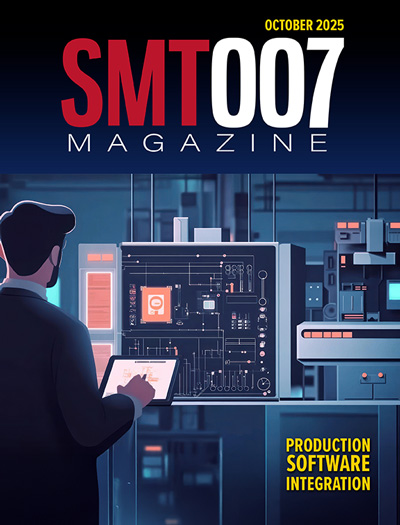-

- News
- Books
Featured Books
- smt007 Magazine
Latest Issues
Current Issue
Production Software Integration
EMS companies need advanced software systems to thrive and compete. But these systems require significant effort to integrate and deploy. What is the reality, and how can we make it easier for everyone?

Spotlight on India
We invite you on a virtual tour of India’s thriving ecosystem, guided by the Global Electronics Association’s India office staff, who share their insights into the region’s growth and opportunities.

Supply Chain Strategies
A successful brand is built on strong customer relationships—anchored by a well-orchestrated supply chain at its core. This month, we look at how managing your supply chain directly influences customer perception.
- Articles
- Columns
- Links
- Media kit
||| MENU - smt007 Magazine
Blackfox Delivers Benefits of Custom Solder Training
November 2, 2012 |Estimated reading time: 4 minutes
A little more than one year ago, Olympus NDT, an innovator in the manufacturing of non-destructive testing instruments, completed a five-day, on-site training program with Blackfox Training Institute, based in Colorado. Motivated by growth, and employees with differing levels of knowledge and experience, the training successfully put everyone on the same plane of knowledge in soldering and provided a baseline of experience, according to Kathy Corcelius, production supervisor, and Dan Watson, quality engineer, both of Olympus NDT in State College, Pennsylvania.
.jpg%20(2).jpg) Blackfox, which specializes in IPC certification training courses, also included a “train the trainer” segment, that leaves companies with more than just five days’ worth of training: Going forward they have the take-away value of a resident expert in cutting edge techniques and methods for hand soldering. The positive benefits are far reaching, from decreased rework and increased throughput time, to higher levels of employee confidence, customer satisfaction, and awareness, according to Corcelius and Watson, who agreed that the scope of the training was impressive.
Blackfox, which specializes in IPC certification training courses, also included a “train the trainer” segment, that leaves companies with more than just five days’ worth of training: Going forward they have the take-away value of a resident expert in cutting edge techniques and methods for hand soldering. The positive benefits are far reaching, from decreased rework and increased throughput time, to higher levels of employee confidence, customer satisfaction, and awareness, according to Corcelius and Watson, who agreed that the scope of the training was impressive.
Having been referred by their sister company/corporate headquarters in Waltham, Massachusetts, Olympus NDT invited Blackfox to their facility. Over the course of five days, assemblers and other production staff, as well as engineers, took part in a variety of lecture-style seminars and hands-on, individualized soldering and wire-bonding instruction led by Dorothy Cornell, director of education and a master trainer for Blackfox.
“It began with classroom theory, presentations, demonstrations on fasteners and soldering, and then switched to one-on-one training. Employees received feedback on their individual soldering performance. However, before training even began, Dorothy completed an in-depth tour of the production area, inspecting, and gaining an understanding of internal processes. She provided feedback on equipment, soldering irons being used, and recommendations on temperature--even types of soldering-iron tips that may work better for the work we do at Olympus,” said Watson.
Corcelius was especially struck by the detailed, individualized instruction that Dorothy delivered to the Olympus staff:
“She inspected each person’s work, and then made suggestions for things like using too much solder, or too much flux. To fix this particular issue, she recommended flux pens to help with consistency. All 19 assemblers received one-on-one training of this type; others required a different type. Overall, about 32 people received training, many of which were assemblers who actually hand-soldered to a printed circuit board; others used a semi-automated reflow soldering station, performing solder connections to an actual piece of ceramic.”
Even for Corcelius, who has 18 years of experience in production of PCBs, there was something to be learned.
“Some of the theory was new to me, as someone with extensive experience; Dorothy really hit all three levels: Beginning, intermediate and advanced. Even the more advanced soldering employees were engaged. She also helped the engineering staff members, who were able to take away information for their designs going forward, with greater understanding of what production has to deal with later in the process.”
Corcelius and Watson also agreed that perhaps the most important aspect of the training was Blackfox’s preliminary walk-through and observation of current practices, before any training began, in order to have a clear understanding of where the production staff was in terms of their actual environment and practices. The trainer then incorporated examples into her training that came from in-house processes and projects, which was very effective.
The resulting value of the training was immediately obvious. Prior to Blackfox’s visit, employees were not able to do much of their own troubleshooting or rework when there was a short, which was often due to too much solder. Post-training, armed with knowledge about the importance of regulating the amount of solder, including optimum temperature range, the number of instances where assemblers need help troubleshooting has decreased substantially. “When there is a short, it is usually internal, within the transducer. At the employees’ process step, they’ve eliminated many of the shorts. Historically, there were about six shorts per week; this has dropped down to about 3.8 per week on average, since the training. It dropped significantly and immediately,” said Corcelius.
Additionally, said Watson, “The metrics for rework and scrap show that it’s a huge benefit. Customers have reaped the rewards as well. We’ve had very few customer feedback issues, and very few returns for performance since the training was completed.”
As for long-term value stemming from the training, including the refinement of internal processes, which has led to the cutting back of rework, throughput time has improved substantially. “Employees communicated that they felt more valued with the training; it raised their level of confidence, and improved skills and knowledge. There was lots of positive feedback from engineering and production. With the engineers’ raised level of awareness, they are thinking more about how to troubleshoot designs before the soldering stage,” Watson added.
Add to that the layer of “train the trainer” that Blackfox provided, and Olympus now has on-site employees who can reproduce what Blackfox did--an aspect of the training that Watson feels they will most certainly utilize.
Both Watson and Corcelius strongly recommend this type of custom, on-site training and, with the help of their training coordinator at the corporate level, they are trying to expand this knowledge to other Olympus facilities as well.
To other companies considering this type of training, Watson advises, “If you want to reduce your cost, increase your throughput, and satisfy customers, it is well worth the time and money to give people the skills and confidence they need to succeed.” Added Corcelius, “It is a positive thing to offer to your people, and to your customers.”


